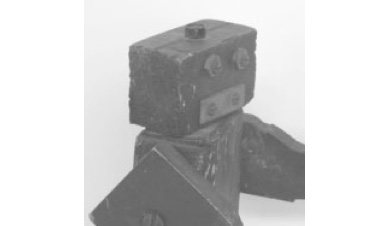


I was antique hunting in rural Pennsylvania a year ago when I came upon a homemade toy robot standing on a shelf between a Depression-glass water pitcher and a tarnished hotel ashtray. The robot looked to be fifty years old. I had to have it. Now it sits on my desk at home. I call it folk art because I don’t want visitors to think it’s garbage, even though it is garbage, made of a handyman’s scrap. The robot’s flat-black paint is peeling in several places and its metal-screw eyes are rusted. It stands fourteen inches high, is made of wood, and has the iconic look of the mid-twentieth century robot, as depicted in comics, movies, and toys of the day. The robot’s blocky stance, its implacable expression, its demeanor I find both charming and haunting. If someone were to ask me to select an object from my house that best represents American culture in the twentieth century, this old handmade toy would be the first thing I’d choose.
If you grew up between 1950 and 1970, you might recognize my handmade toy as a knock-off of manufactured toy robots of the period. I know about toy robots of the twentieth century because I loved them as a child and I collect them now The Japanese made the best ones. These were colorful, inventive, and very popular wind-up and battery-operated toys made of artfully wrought tin. The Japanese marketed them exclusively to American children. Had anyone seriously studied Japanese ingenuity in toy design and manufacture shortly after World War II, it would have been obvious that the Japanese were destined for great things. Nobody has made better or prettier toy robots. My homemade toy clearly mimics these Japanese beauties, except there’s nothing beautiful about mine. For one thing, mine is made of wood, not lithographed tin.
Apparently, a farmer made this for his son, probably around 1960. He could have bought his boy a lovely Japanese-made, tin toy robot at the local five-and-dime for just one dollar, but I suspect that he couldn’t spare a dollar. He might have been a proud man, aware of his ability to construct a perfectly serviceable toy. In fact, my robot’s construction shows considerable thought. Most notable is the toggle switch inserted in its back. Clearly, this maker wanted his child to pretend that, at the flip of this switch, the robot would walk and, perhaps, talk and take commands. I picture the farmer fingering through scraps and screws on his cluttered workbench, looking for just the right pieces for his creation. The toggle switch, left over from a small engine repair, was an inspired touch. The robot’s arms and legs swing from their wood-screw joints. Its head turns. Only a man experienced in shop-work would have thought to insert a washer between the head and torso to enable the robot’s (screwed-down) head to swivel as it does. The bolt-end projecting from the top of the robot’s head -- mimicking an antenna -- suggests a mature sense of design. The feet are not simple rectangles but, rather, oblong octagons that give the creature a Frankenstein monster’s clumsiness. The hands are pincers instead of blunted fists. They almost look like open wrenches. The more I examine the robot, the more I respect the man who made it.
But how disappointed his son must have been to receive this homemade replicant instead of the shiny, battery-operated, store-bought wonder his peers played with! As the robot’s mostly-intact paint suggests, this handmade toy saw little play. And thus I have conjured a sad scene: the well-meaning but frugal father taking time from his too-busy day to build the toy his son wants so badly. And yet the man fails because the boy wants something that only money can buy. Perhaps the ten-year-old boy didn’t yet understand the necessity of his father’s frugality. A dollar in 1960 was equivalent to about $7.50 now. That’s enough for a meal. Perhaps the father didn’t understand that, in an age of increasing reverence for machine-made, mass-produced goods, a handmade toy is an embarrassment. By 1960, seventy percent of the U.S. population was urban. Nobody wanted to be “down on the farm” any more. The general public’s disdain for all things rural was at an all-time high, voiced in derisive terms like “hokey,” “corny,” “home-spun,” “corn-pone,” “hick,” “hayseed,” and “country bumpkin.” I recall that the most dreaded insult in my grade school in the 1960s was “farmer.” This charming wooden toy that now sits on my desk would have made us aspiring sophisticates smirk. We would have called it a “farmer’s toy.”
The most striking detail of my robot’s construction is its face. It has rusted metal nuts for eye sockets and round-headed screws for eyeballs, the screw-slits mimicking a squint. The robot’s mouth is a rectangle of metal that suggests a grimace punctuated by two rusted screws that might represent compressed lips. It seems to be a face acquainted with hardship and pain. This is clear evidence of an adult’s vision: in mid-twentieth century America, there was nothing pleasing or hopeful about robots. They were a means to an end. Japanese toy manufacturers were careful to observe this Western notion of the robot as joyless machine, even though the Japanese felt very differently about technology. Like most Americans of the mid-twentieth century, the farmer who made my toy robot placed himself in a lineage of men and women who worked with their hands and worked for themselves. They were not enamored of the machine, which they considered stupid, heartless, and potentially harmful. His America was a nation of farmers or had been until recently. He remembered how few manufactured goods his father needed and recalled fondly that his grandfather built everything he owned, with the exception of his plow and tractor.
By 1960, the farmer’s version of the robot was a too-familiar fixture of sci-fi and fairly well-worn. Japanese toy makers gave it a fanciful spin but I don’t know that the popularity of robot toys – which peaked about 1960 -- reflected children’s fascination with technology or monsters or futurity or some confusion of all three. I am certain only of this: the appearance of Astro Boy (“Mighty Atom”) in 1963 changed everything American children knew about robots. Astro Boy had been a manga hero in Japan since 1952. He grew so popular that Japanese TV syndicated an anime version of his story. That same cartoon program appeared (dubbed in English) on American television from1963 through the 1970s. My friends and I loved it. The robot as a cute, friendly boy? Yes, it made all the sense in the world. Astro was a robot that wasn’t a robot, a boy who wasn’t a boy, and an Asian who didn’t look Asian. He was, I realize now, the quintessential hybrid who broke more political and cultural constraints than I could fathom at the time. All I knew was that he was heroic and beautiful and I wanted him to be my friend. Later, I learned that the Japanese have always viewed their robots as friends, collaborators, and pets. (And when their robots are evil, they fight each other, not humans.) That is why the wide array of robot toys the Japanese manufactured for and sold exclusively to their own children are highly valued by collectors today: these toys embody a vision of technology that American children of my generation never saw until we met the irrepressibly good and always positive Astro Boy.
As the twenty-first century is an age of diversity, it makes sense that our robots now inhabit the full spectrum of personalities and proclivities. Robots today are lovers and killers, friends and teachers, goofballs and geeks. Some are so human they betray their mechanical origins only in their Aspergerian inability to emote or empathize, which makes them vulnerable and sympathetic. It is possible that when my farmer gave his son this handmade robot, the boy apprehended a world of much greater complexity than his father knew – the world we children would grow into. Like me, the boy may have become an avid fan of Astro Boy. His father’s robot, with its pincered hands and grimaced expression and Frankensteinian feet, is too clearly a product of a generation that played it safe, kept difference at a distance, and lived in fear of annihilation. Sputnik may have fascinated, not frightened, the boy (the way it fascinated my older brother, who kept a model of Sputnik on his desk). New technologies, like the Princess phone and the transistor radio had already begun to change ideas of personal space, offering teenagers more mobility and privacy and deepening the divide between grownups and children.
In other words, no father in 1960 could have seen the rapid, unsettling changes to come. A Pennsylvania farmer, especially, hardly stood a chance of countering the counter-cultural tide that would flood his son’s life. I picture his son politely receiving his gift of this homemade toy robot, struggling to show his joy and appreciation as he watched his father’s anxious face. Maybe the boy stood the robot on his desk, much as it stands on my desk, except the boy did not look upon it with affection or appreciation. More likely, the handmade toy made him wince as he envisioned his father’s earnest labor and considered his own guilt for secretly disliking the old man’s gift. Eventually, maybe sooner than later, he exiled the robot to a toy box in the closet. And there it stayed for years, until his father carried the box into the basement after the boy left for college. Maybe the farmer thought nothing of seeing the untouched toy. Maybe he shrugged it off. It is telling that, of all the toys the boy might have reclaimed later, he did not claim this one.

I imagine the handmade toy robot ended up at the antiques store after an auction of the farmer’s estate, some years after his death when his wife decided to downsize. The farmer’s son is still alive, surely. He can’t be older than 60. If he recalls the toy robot his father made for him long ago (I don’t see how he would not recall such a distinctive object), he may regret having let it go. Or maybe not. Maybe it would have haunted him as a too-painful a reminder of his father’s world — the dirt floor of the old man’s shop, the claustrophobic gloom of his ancient barn, the reek of manure, the stink of penned animals. Maybe the boy, now a grandfather himself, is happy to have left all of that far behind, a world that grows ever smaller in his recollection like the receding glimpse of his father’s farm in the rearview mirror the day the boy-as-young-man sped away to a better destination.

